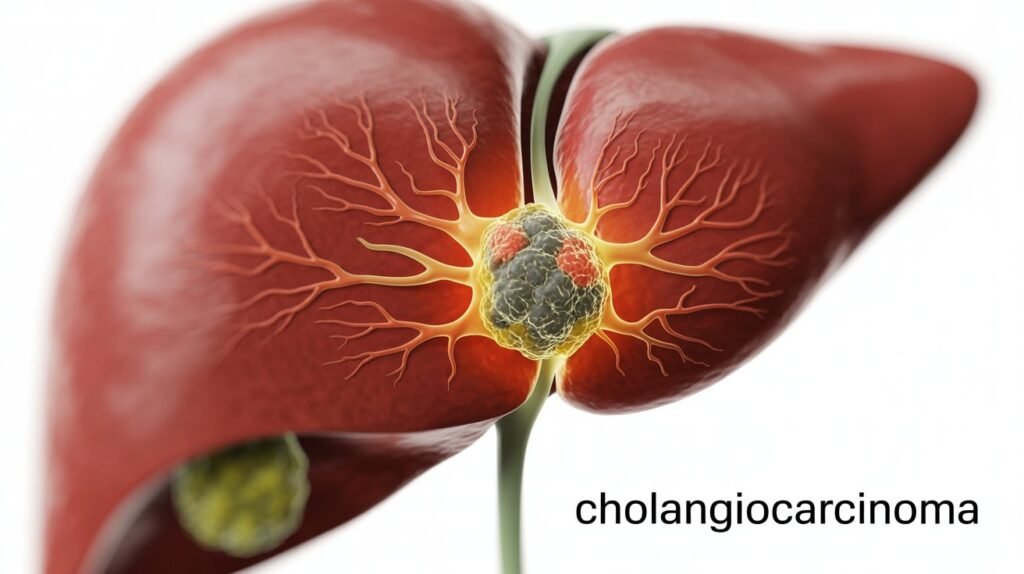Cholangiocarcinoma is a rare but serious type of cancer that develops in the bile ducts. These ducts play a vital role in carrying bile, a fluid that helps digest fats, from the liver and gallbladder to the small intestine. Though not very common, this cancer is aggressive and often diagnosed at a later stage, making awareness of its symptoms, causes, and treatment options extremely important.

What is Cholangiocarcinoma?
Cholangiocarcinoma, also called bile duct cancer, begins in the cells that line the bile ducts. Depending on where the tumor forms, it is classified into three main types:
- Intrahepatic cholangiocarcinoma – develops in bile ducts inside the liver.
- Perihilar cholangiocarcinoma (Klatskin tumor) – found at the junction where ducts leave the liver.
- Distal cholangiocarcinoma – forms in ducts near the small intestine.
Understanding the type helps doctors plan the right treatment and predict outcomes.
Symptoms of Cholangiocarcinoma
Symptoms of cholangiocarcinoma often don’t appear until the disease has advanced. Early detection can be tricky, but knowing the warning signs can save lives.
Common symptoms include:
- Jaundice (yellowing of skin and eyes)
- Dark urine and pale stools
- Persistent abdominal pain (especially on the right side)
- Unexplained weight loss
- Itchy skin
- Fatigue and loss of appetite
For example, a 45-year-old patient might visit a doctor for prolonged jaundice, thinking it’s hepatitis, but further tests may reveal cholangiocarcinoma. That’s why timely diagnosis is so crucial.
Causes and Risk Factors of Cholangiocarcinoma
While the exact cause of cholangiocarcinoma is not always clear, certain risk factors increase the chances of developing it.
Possible causes and risk factors:
- Chronic inflammation of the bile ducts (e.g., primary sclerosing cholangitis)
- Liver diseases like cirrhosis or hepatitis B and C
- Bile duct stones or choledochal cysts
- Parasitic liver infections (common in some Asian countries)
- Family history of bile duct or liver cancers
- Older age (commonly seen in people over 50)
Genetic mutations may also play a role in the development of cholangiocarcinoma, though research is ongoing.
How is Cholangiocarcinoma Diagnosed?
Doctors use a combination of imaging, lab tests, and biopsies to confirm diagnosis.
- Blood tests – check liver function and tumor markers.
- Ultrasound, CT scan, or MRI – help visualize tumors in the bile ducts.
- Endoscopic procedures (ERCP, EUS) – to examine bile ducts more closely.
- Biopsy – confirms the presence of cancerous cells.
Early detection improves treatment outcomes, but unfortunately, most patients are diagnosed at an advanced stage.
Treatment Options for Cholangiocarcinoma
Treatment for cholangiocarcinoma depends on its location, stage, and the patient’s overall health.
Main treatment approaches:
- Surgery
- If the tumor is small and localized, surgery to remove part of the bile duct or liver may be an option.
- Liver transplantation may be considered in select cases.
- Radiation Therapy
- Used to kill cancer cells or shrink tumors before surgery.
- Chemotherapy
- Helps control cancer growth and ease symptoms, especially when surgery isn’t possible.
- Targeted Therapy & Immunotherapy
- Newer treatments that attack specific cancer cells or boost the immune system to fight cancer.
- Palliative Care
- Focuses on improving quality of life and managing symptoms in advanced stages.
Living with Cholangiocarcinoma: Patient Care & Support
A cholangiocarcinoma diagnosis can be overwhelming, both for patients and families. Alongside medical treatment, emotional support, lifestyle changes, and counseling play an important role.
- Eating a liver-friendly diet
- Regular exercise (as tolerated)
- Seeking support groups for emotional strength
- Regular check-ups and follow-up scans
Conclusion
Cholangiocarcinoma is a rare but aggressive cancer of the bile ducts. Knowing the symptoms, understanding the risk factors, and exploring treatment options can help patients and caregivers take timely action.
FAQs About Cholangiocarcinoma
1. What is the first sign of cholangiocarcinoma?
The most common early sign is jaundice, where the skin and eyes turn yellow. However, some patients may also experience abdominal pain or weight loss.
2. Is cholangiocarcinoma curable?
Cholangiocarcinoma can sometimes be cured if detected early and treated with surgery. In most cases, treatment focuses on managing the disease and improving quality of life.
3. Who is at higher risk of bile duct cancer?
People with chronic bile duct inflammation, liver diseases like cirrhosis, hepatitis B/C, or bile duct cysts have a higher risk of cholangiocarcinoma.
4. How long can you live with cholangiocarcinoma?
Survival depends on the stage at diagnosis. Early-stage patients who undergo surgery may live several years, while advanced cases often focus on palliative care.





